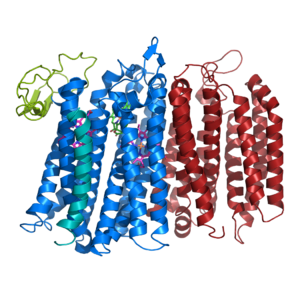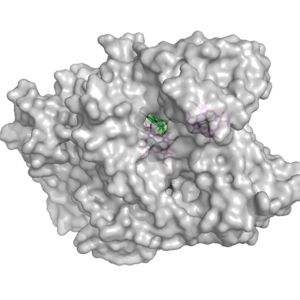Sandbox Reserved 1600
From Proteopedia
(Difference between revisions)
| Line 12: | Line 12: | ||
=Structure= | =Structure= | ||
[[Image:Bd oxidase structure (basic).png|300 px|right|thumb|Figure 1. bd oxidase; two structurally similar transmembrane helices in blue and red; CydX subunit in teal; Q loop in lime green. ]] | [[Image:Bd oxidase structure (basic).png|300 px|right|thumb|Figure 1. bd oxidase; two structurally similar transmembrane helices in blue and red; CydX subunit in teal; Q loop in lime green. ]] | ||
| - | The overall structure contains 19 transmembrane helices that are arranged in a nearly oval shape. The protein contains two structurally similar subunits each containing nine helices (blue and red) and one smaller subunit, CydX, with one transmembrane helix. The subunits are interacting using hydrophobic residues and symmetry at the interfaces. The CydX subunit, whose function is not currently known, is positioned in the same way as CydS, which is found in E. coli bd oxidase. Due to its similar structure and position, it has been hypothesized to potentially stabilize heme b558 during potential structural rearrangements of the Q loop upon binding and oxidation of quinol. The Q loop is shown in lime green, and is a hydrophilic region above Cyd A. The lack of hydrogen bonding in this hydrophobic protein allows the protein to be flexible and go through a large conformational change for reduction of dioxygen. | + | The overall structure contains 19 transmembrane helices that are arranged in a nearly oval shape (Fig 1.). The protein contains two structurally similar subunits each containing nine helices (blue and red) and one smaller subunit, CydX, with one transmembrane helix. The subunits are interacting using hydrophobic residues and symmetry at the interfaces. The CydX subunit, whose function is not currently known, is positioned in the same way as CydS, which is found in E. coli bd oxidase. Due to its similar structure and position, it has been hypothesized to potentially stabilize heme b558 during potential structural rearrangements of the Q loop upon binding and oxidation of quinol. The Q loop is shown in lime green, and is a hydrophilic region above Cyd A. The lack of hydrogen bonding in this hydrophobic protein allows the protein to be flexible and go through a large conformational change for reduction of dioxygen. |
==Hemes== | ==Hemes== | ||
| Line 18: | Line 18: | ||
==Potential Oxygen Entry Site== | ==Potential Oxygen Entry Site== | ||
| - | [[Image:Potential_oxygen_entry_site.jpg|300 px|right|thumb|Figure 2. ]] | + | [[Image:Potential_oxygen_entry_site.jpg|300 px|right|thumb|Figure 2. Surface of the potential oxygen entry site; Heme D shown in green]] |
| - | Heme D is the hypothesized spot for the oxygen to enter the protein. Heme D | + | Heme D is the hypothesized spot for the oxygen to enter the protein. Heme D is directly connected to the protein surface on CydA and contains a solvent accessible substrate channel (Fig 2.) |
| - | + | ||
==Electron Source== | ==Electron Source== | ||
Revision as of 01:26, 23 March 2020
bd oxidase; Geobacillus thermodenitrificans
| |||||||||||


